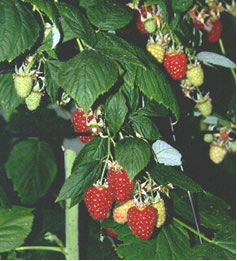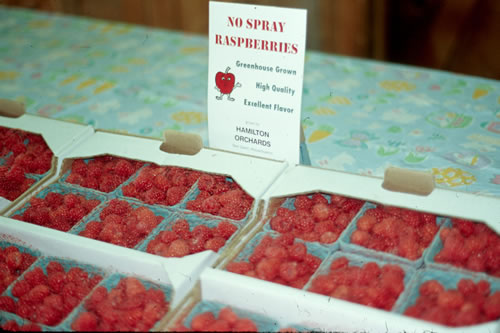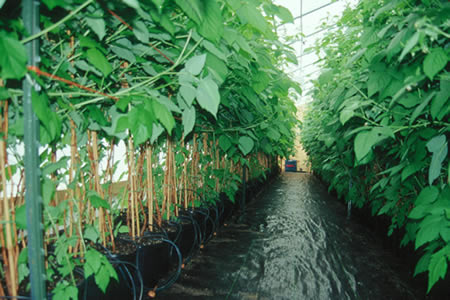Greenhouse Raspberry Production for Winter SalesSonia Schloemann, UMass
Extension Small Fruit Specialist
|
|
The appeal of this system to A third appeal is the advantage of producing fruit in a controlled environment where the above ground portion of the plant is not subjected to wetting by rain or dew. Irrigation water is delivered to the roots via a drip system, |
 Figure 1. "Tulameen' raspberries grown in Cornell University greenhouses. Photo courtesy of Dr. Marvin Pritts. |
One barrier to this system until recently was the problem of pollination. Hand pollination was far too labor intensive, and honeybees were poorly adapted to greenhouse use. With the advent of commercial bumblebee production, this barrier was removed and Dr. Pritts saw an opportunity to develop a system for greenhouse production of raspberries. After several years of research, this system has been developed to the point where its is ready for on-farm testing to see if it can live up to the promise is seems to hold.
Putting the System into Practice
Hamilton Orchards, in New Salem, Massachusetts,
is a typical
With the support of some grant funding from
the Department of Food and Agriculture’s Agro-Environmental Technology
Program, technical assistance from UMass Extension, and the investment
of a lot of personal resources and ingenuity, Bill Hamilton set
out to see for himself if this system could
work for his farm. In the spring of 2000, 900 bare-root raspberry
plants (600 ‘Tulameen’ and 300 ‘Encore’)
were planted into pots and set up in neat rows with trickle irrigation
supplying them with water and fertilizer. There they grew throughout
the summer, each producing 2-3 primocanes
3-5’ long. A site for a new 72’ x 34’ greenhouse was leveled and
prepared for construction. An additional 300 dormant bare-root,
long-stem ‘Tulameen’ plants were ordered
from
|
|
With completion of the greenhouse construction delayed until
early January 2001, Bill was not able to move plants into the
greenhouse until about a month later than planned, about |
Once in the greenhouse, daytime temperatures were maintained at 65˚F during the day and 55˚F at night. As the foliage began to emerge and expand, weekly pest scouting began. A total of 788 pots (506 ‘Tulameen’, 164 ‘Encore’, and 118 long-stem ‘Tulameen’) were moved into the greenhouse. Extra pots remained in the cold storage and were moved out-doors in the spring.
Six weeks after moving the plants into the greenhouse, they began to show swelling flower buds. It was time to bring in the bumblebees. At the same time, pest scouting revealed the presence of first, two-spotted spider mites and later, European red mites. These pests were found first among the long-cane plants and later spread throughout the greenhouse. Since bumblebees were being introduced into the greenhouse at this time, insecticide/miticide sprays were out of the question. The first hive was moved in on March 13th. The following day, a release of predatory mites (a combination of Neoseiulus fallacis and Phytoseiulus persimilis) were released to control the infestation of pest mites. A follow-up release of predators was made one month later and the pest mites never reached damaging levels.
As the pollination period progressed, a second unanticipated problem emerged. It began to appear that the bumblebees were not pollinating the flowers evenly. Misshapen fruit were developing as though flowers were only partially pollinated. At first we thought that we had insufficient numbers of bumblebees and brought in a second and later a third hive. When the uneven pollination persisted, we looked for other factors. After installing recording hygrothermographs to monitor temperature and relative humidity simultaneously, we concluded that the low night temperatures were causing high humidity (100%) in the greenhouse for 10 – 14 hours each 24-hr cycle. This was causing the pollen to become too ‘sticky’ to be adequately transferred by the bees. The problem was partially resolved by simply increasing the temperatures by 10˚F at night. In the long term, it may be necessary to install a concrete floor in the greenhouse to reduce the amount of moisture coming from the ground under the greenhouse. The Cornell research had not encountered this problem because it was all done in glass houses with concrete floors where humidity is typically very low. So low, in fact, that supplemental humidity had to be provided in order for pollen, once transferred, to germinate.
Another humidity related problem emerged in the harvest phase of production and that was the development of powdery mildew infections on the leaves and Botrytis cinerea fungal infections of the canes. Again, these problems were reduced mainly through the increase of night-time temperatures to lower the humidity in the greenhouse.
The first fruit were picked on April 15th (6 weeks from the beginning of bloom). A total of 2,087 1/2 pints of high quality fruit were harvested from the 788 plants for an average of 2.64 half-pints per plant. This is similar to the yield achieved in the Cornell trials. Higher yields (50 – 60%) could have been achieved if the pollination problem had been anticipated. The Cornell trials suggest that yields of 8 – 11 half-pints per plant in the second and third year of production can be expected.
All harvested fruit was sold at a consistent price of $42/flat of 12 half-pints. This equals $3.50 per harvested half-pint for a total income of $7,304.50. This translates to $2.98 per square foot of greenhouse space. If projected yields of 8 – 11 half-pints are achieved in subsequent years, returns would increase to approximately to over $9.00 per square foot of greenhouse space. In 2001, peak harvest were the weeks of May 6th and May 13th when over 530 half-pints were picked each of those weeks. The highest yield was achieved by the own-grown, bare-root ‘Tulameen’ plants. These plants produced 25% more marketable fruit than the long-cane plants or the own-grown ‘Encore’ plants.
Economics of the System
|
|
The profitability of this system hinges on the cost of producing the fruit. In this case, the cost for establishing this crop was high, especially since the farm had no existing greenhouse to use. A farm with an existing greenhouse will have a distinct advantage in establishing this system. However, costs beyond that of constructing the greenhouse came to approximately $11.70 per pot (Table 1). The costs included plants and potting material, irrigation supplies, bumblebees and mite predators, trellis support, harvest supplies, and production and harvest labor. Income received from the system (based on harvesting 2.64 half-pints per pot and receiving $3.50 per half-pint) was $9.24 per pot. As you can see, in the first year of this project, returns did not meet the costs. However, you may also remember that the pollination problems reduced marketable yield by approximately one third. The |
Conclusions
The economics of this project were, while only
marginally successful, still quite promising. The
| The goal of this project was to ‘test drive’ this system in
the real world and see if it might offer an appealing option
for |
 Figure 3. Hamilton's 'Tulameen' raspberries ready for sale in April |
For anyone interested in learning more about this production system, consider contacting the following resources:
Guides:
1. Proceedings from the Greenhouse Raspberry Production Workshop, 1999. Available for $20 by contacting Dr. Marvin Pritts, 119 Plant Science Bldg., Cornell Univ., Ithaca NY 14853, mpp3@cornell.edu
2. Winter Greenhouse Raspberry Production website:http://www.hort.cornell.edu/department/faculty/pritts/Greenhouse/Frontpage.htm.
Literature:
1. Pritts, M. P., Winter Raspberry Production in a Greenhouse. Fruit Notes, Vol. 65, 2000. 20-21.
2. Pritts, M. P., W. Langhans, T. K. Whitlow, M. J. Kelly and A. Roberts. 1999. Winter Raspberry Production in Greenhouses. HortTechnology, Vol. 9 No. 1, 13-15.
3.
Pritts, M. P., Raspberries
in Winter: An Alternative Growing System
for Northern States.
 |
©Copyright 2001 University of Massachusetts Amherst, Massachusetts, 01003. (413) 545-0111. Produced and maintained by the UMass Fruit Team. This is an official page of the University of Massachusetts Amherst campus. |
 |
